Here’s another excellent article by Mikey. It will show you how to take a worn or abused Albrecht keyless chuck and rebuild it to be like new. – Rob
I was really stuck. No, this wasn’t the ordinary kind of stuck. This was one of those seriously awful expletive deleted kinds! Having just bought my first “genuine Albrecht chuck” on eBay, I was stoked. I recall thinking, “I’ll just overhaul that puppy and have me a precision keyless chuck for cheap!” Talk about naïve – that first chuck brought me to my knees!
It resisted all my efforts to get it apart, had an arbor stuck in there that didn’t fit any of my machines, and I was beginning to have that sick “paperweight” feeling. Yes, I did the penetrating oil and the hammer taps every time I passed it for three days, repaired my strap wrench twice, spoke a lot of “nice” words to it, lost sleep over it and almost picked up my torch! Pathetic but all true. Sound familiar?
I looked for help on the net and, to my dismay, found very little! I won’t recap the misery that ensued but I did eventually get that chuck rebuilt and promised myself that if I ever learned to work on these things effectively that I would share it with my fellow hobbyists because nobody should have to go through that! This is my attempt to fulfill that promise.
I have since rebuilt seven of these eBay specials and have learned a thing or two that work for me and I hope they work for you. If you’re stuck like I was then read on and we’ll learn how to get the thing apart, get the arbor out, and get it back together again as painlessly as possible.
As always, work safely and proceed at your own risk.
We will use the C80-J2, a 5/16″ capacity chuck that I bought on eBay,
for our rebuild. Its jaws were galled from a spinning drill bit in an
over-tightened chuck and were replaced during this rebuild. The rest of
the chuck showed little discernible wear.
Albrecht Anatomy 101
The 5/16″, 3/8″ and ½” chucks in Albrecht’s Classic Series have the same anatomy, differing only in size. Once you know how to work on one of them you will know how to work on all of these. I have not worked on the other chucks in the series but suspect they are the same.
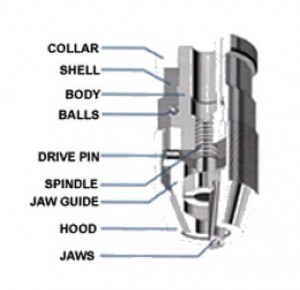
Typically, there are three obstacles you will face when disassembling an Albrecht chuck: getting the collar locking screw out, getting the hood off and getting the arbor out. The rest is easy. I would encourage you to read this to the end before beginning work on your chuck as there are some CAUTIONS to be aware of. When working on precision assemblies with parts that are expensive to replace please work carefully and take your time.
Disassembly
Before breaking down your chuck consider putting it in your drill press or lathe and use a steel brush to clean the knurled parts and gently polish up the smooth areas. I suggest wiping it down with alcohol or lacquer thinner first to avoid burnishing in the surface contamination. This is best done before you break it down so grit doesn’t get into your nice clean chuck.
- Remove the slotted collar locking screw. Caution: Be sure to use a screwdriver that fully engages the slot to avoid damaging the head. Quite often these screws are in there really tight. A 5/16″ chuck takes a metric size 4.5 screwdriver blade, while 3/8″ and ½” chucks both take a size 5.5. I suggest you clamp the chuck in a padded vise so you can apply controlled pressure directly in line with the screw. Once the screw is out wedge the tip of an old screwdriver into the slot in the collar to open it and the collar will simply slip off the tail of the body.
- Now we need to get the hood off. Albrecht recommends clamping the shell in a fixture and removing the hood with a strap wrench. Okay, maybe with their strap wrench! My Klein strap wrench has only been able to budge the hood on one chuck but by all means try it. If it fails …Here is an option that does not damage the hood and gets the tightest hood off in a few seconds. Trust me – you want to make these.
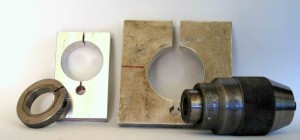 These two 3/8″ thick aluminum plates have holes bored to the diameter of the body and hood. Once the slots are cut the hole opens just enough to fit nicely. The small secondary hole is to prevent the plate from cracking under compression. By the way, the factory uses this type of plate (1/4″ thick) to hold the shell when removing hoods. Once made, label them so another chuck of the same size can be worked on. You will need separate plates for different sizes of chucks, of course, but they are simple to make with a hole saw followed by a boring head.
These two 3/8″ thick aluminum plates have holes bored to the diameter of the body and hood. Once the slots are cut the hole opens just enough to fit nicely. The small secondary hole is to prevent the plate from cracking under compression. By the way, the factory uses this type of plate (1/4″ thick) to hold the shell when removing hoods. Once made, label them so another chuck of the same size can be worked on. You will need separate plates for different sizes of chucks, of course, but they are simple to make with a hole saw followed by a boring head.
- The smaller plate slips onto the body just below the angled step, while the larger one clamps onto the upper part of the knurled area of the hood. The threaded part of the hood is at the lower part of this knurled area and no pressure is applied to it if you position the plate as shown.
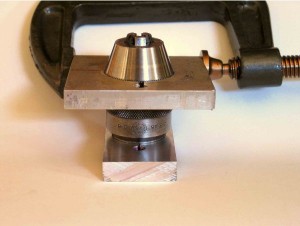 A large C-clamp is applied to the slotted side of the larger plate and the lower plate is clamped in a vise. Tighten the C-clamp so it does not slip. If the shell spins, tighten the vise (degreasing the plate and shell really helps here). Use the screw of the C-clamp for leverage and even the tightest hood will come right off (RH thread).
A large C-clamp is applied to the slotted side of the larger plate and the lower plate is clamped in a vise. Tighten the C-clamp so it does not slip. If the shell spins, tighten the vise (degreasing the plate and shell really helps here). Use the screw of the C-clamp for leverage and even the tightest hood will come right off (RH thread).Once you have loosened the hood but before you take it off, move to your workbench and work over a shop towel or tray.
- Remove the hood and move the spindle up (turn the part of the body where the collar used to sit) about half way and slip the jaws out. Now screw the spindle up further and it will push the jaw guide up so you can lift it off the shell.
- Remove the spindle and body by pulling them straight out. Remove the 25 ball bearings. Caution: don’t drop them on the shop floor as you will need ALL of them.
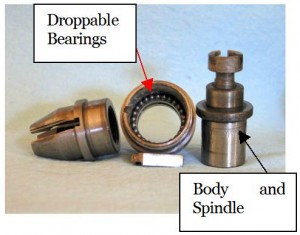 You should now be able to see the end of the arbor through the rear of the body, which can sometimes be driven out with a punch. Caution: There is great potential for damaging the internal threads of the body here. I would suggest slipping a small piece of thin-walled tubing in there before using a punch. Also be very sure to fully support the end of the body where the arbor exits before you let the BFH fall.
You should now be able to see the end of the arbor through the rear of the body, which can sometimes be driven out with a punch. Caution: There is great potential for damaging the internal threads of the body here. I would suggest slipping a small piece of thin-walled tubing in there before using a punch. Also be very sure to fully support the end of the body where the arbor exits before you let the BFH fall.
- It isn’t unusual to find that the arbor is in there so tight that a punch fails to budge it. Here is an option that has worked every time I needed it.
- Cut the arbor, leaving about ¼” of arbor sticking out. Put the spindle body in your lathe and drill and tap for a bolt of your choice (I use a 5/16-24) at least ½” deep. You want this bolt in the center of the arbor stub so tension is applied along the axis of the arbor.
- Transfer the body to a padded vise and find a socket/pipe/hollow thing that fits. Using a heavy washer under the bolt head, tighten the bolt into the tail of the arbor stub through the socket. The outer edge of the socket bears on the spindle body. Most of the time this will pop the arbor out but if it doesn’t, use your punch from the inside and give it a few taps and the arbor should come out.
- If your arbor is through-hardened (most “hardened” arbors I have seen are case hardened) and you cannot drill and tap it then your best option is to use a hydraulic press. Support the end of the body, not the ring halfway up, when doing this.
Your chuck is now completely disassembled and you can clean your parts with degreaser, then hot soapy water and blow them out. After cleaning the spindle and body threads wipe them with lacquer thinner before setting them aside. Now you can begin inspecting the parts to see if any are damaged enough to warrant replacement.
Smooth out any burrs with a diamond file. By the way, Eze-Lap sells a little diamond-coated hook sharpener with a shank about 3/16″ OD and a coned tip that works well on burrs inside a chuck’s taper socket.
Now that the chuck is apart you can see how it works. As the hood is tightened the spindle moves up. The jaws, which are linked to the spindle, move up in the jaw guide. Constrained by the inside of the hood the jaws close on the bit while the spindle pushes up on the bit from below. The result is that the bit, once locked, effectively becomes a solid part of the chuck, thereby transferring the accuracy of the chuck to the bit. As cutting forces are encountered the chuck actually tightens; the greater the force the tighter the chuck becomes. Neat design, huh?
The above scenario is only true as long as the spindle and body are clean and dry. If oil gets into the spindle assembly it cannot resist the cutting forces and the drill will slip – this is the Achille’s Heel of keyless chucks of this design and the fault of the user. Attempts to over-tighten the chuck will not work for long and the drill can slip badly enough to gall even the hardened jaws of an Albrecht chuck. This is why so many chucks sold on eBay have severely tightened hoods, really tight collar-locking screws, vise marks on the collars and worn jaws – oil in the spindle! The point I want to make is that if a drill ever spins in your Albrecht chuck, please take the time to disassemble it and clean the spindle assembly.
As for the stuck arbors, well, don’t get me started …
Assembly
Guy Lautard wrote a treatise on this subject in one of his excellent Bedside Readers. There were several (paraphrased) notes there that are important:
- Inspect the inside of the hood. The jaws ride on this surface and there needs to be some “tooth” to it so take some 320 grit sandpaper and scuff the inside of the hood where the jaws ride – they will look shiny and you’re trying to remove the shine.
- The spindle and body must be clean and dry. 🙂
Except for the area holding the bearings a very light application of lubricant is all that is necessary. Assembly is essentially just the reverse of the above.
 Apply grease to the bearing seat. I also use a light coat of grease to the area leading out the back of the shell, toward the arbor taper, to prevent any grit from working into the bearing area.
Apply grease to the bearing seat. I also use a light coat of grease to the area leading out the back of the shell, toward the arbor taper, to prevent any grit from working into the bearing area.
- Insert all 25 ball bearings. I use an acid brush to apply grease during assembly and stabbing down onto a bearing traps it at the tip of the brush, allowing you to transfer it to the bearing seat area. A broad-tipped tweezers is faster but avoid squeezing too hard or you’ll launch the bearing. Remember the shop towel!
- Once all the bearings are in place you can apply light grease to the underside of the body where it contacts the bearings (don’t get grease on the front side) and slide it into place.
- Apply some oil to a Q-tip and lightly oil the jaw guide slots where the jaws will ride. I also lightly oil the inside of the hood at the jaw contact points.
- Insert the clean dry spindle (LH thread) into the clean dry body. Caution: Okay, I’ll spare you further comments about oil but you get the point.
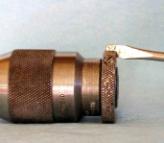 Slide on the jaw guide, being sure to line up the drive pin. If your drive pin is somehow damaged you can replace it with a standard roll pin cut to size. Now spin the spindle up about halfway and insert the jaws. (Contrary to what I have read on the net, the jaws are not matched to their carrier so numbering or otherwise marking their original position is not necessary. If they were matched what would you do with replacement jaws?)
Slide on the jaw guide, being sure to line up the drive pin. If your drive pin is somehow damaged you can replace it with a standard roll pin cut to size. Now spin the spindle up about halfway and insert the jaws. (Contrary to what I have read on the net, the jaws are not matched to their carrier so numbering or otherwise marking their original position is not necessary. If they were matched what would you do with replacement jaws?)
- Lightly oil the threads on the shell and screw the hood in place. Put the chuck back in your fixture and tighten the hood with a strap wrench. Do not apply excessive pressure here – just snug it. It gets tighter in use.
- Wedge a screwdriver into the slot of the collar to open it up. Slide the collar up against the bottom of the shell, leaving just a tiny bit of clearance so the hood moves freely. Lightly oil the collar locking screw and just snug it down – you do not need excessive pressure on this screw.
Conclusion
Congratulations, you’re done! Your chuck should now feel smooth and precise and is ready to go to work in your shop. No ongoing maintenance is usually required in the hobby machine shop setting. An occasional light coat of oil externally will keep any rust at bay – try Camelia Oil for this … you’ll love it.
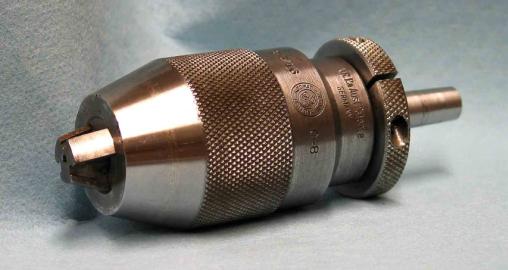 Our rebuilt chuck drilled a 1/16″ (0.0625″)
Our rebuilt chuck drilled a 1/16″ (0.0625″)
hole in the end of a 0-1 steel rod held in an
ER32 collet on my lathe; it went straight in
with no wandering at the tip.
Mikey, 2008
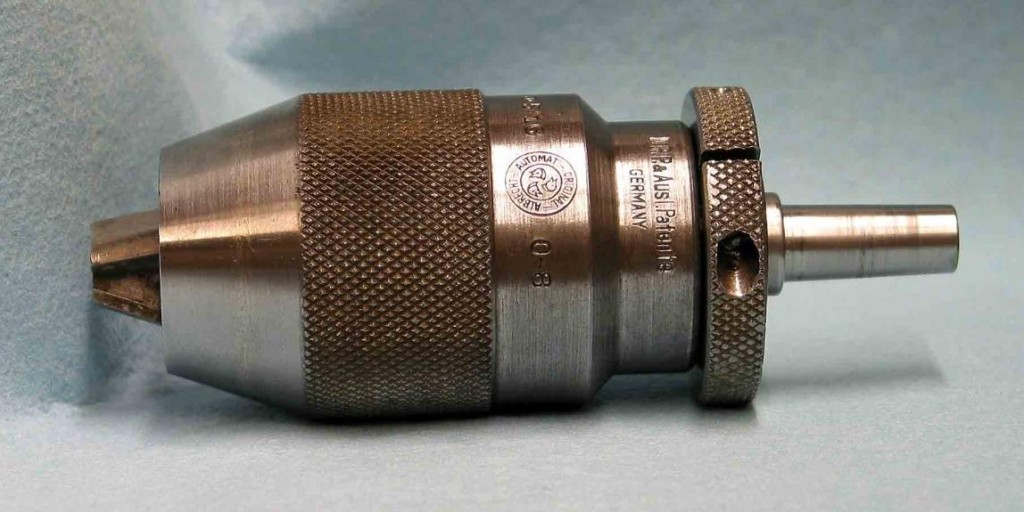
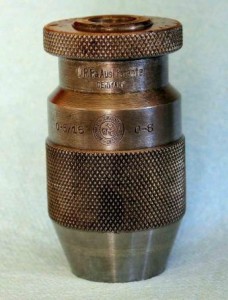
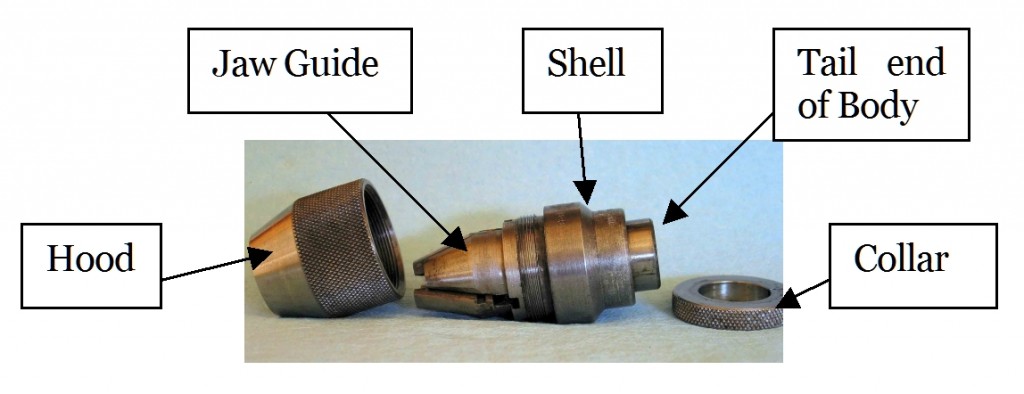
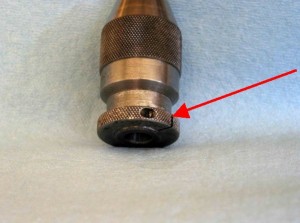
I rebuilt two Albrecht R8 chucks without instructions. Glad to have your article, especially lubrication and holding plates.
Glad it helped, Loren.
Mikey
Great article! I just bought one that was mounted to,I beleive, a CAT 30 holder. It doesn’t need a rebuild, but here is an easy way to remove an arbor while the chuck is assembled. I used a bearing seperator/splitter to remove it and it worked like a charm.
Thanks Bob, hope it comes in handy if you ever do need to get that chuck apart. I’ll remember your bearing separator trick – never thought of that!
Mikey
My Albrecht has an integral R8 shank and no locking screw in the collar. Does the collar still come off? How?
-Nick
Hi Nick. I haven’t had the opportunity to work on a chuck with an integral shank so do not have first hand experience with this but if there is no collar locking screw then I would guess it won’t come off. That shouldn’t impair your ability to overhaul it, however. Good luck, and let us know how it goes.
Mikey
Hey Mikey
I’ve got a Albrecht 130 J2. My drill press has an one piece shaft with a J33 machined on it. Is reaming the body to J33 crazy or should I just replace it with the correct body size?
Thanks
Jason
Hi Jason,
First of all, you do nice work! I enjoyed your site and definitely admired your work.
Most drill press spindles have a female Morse Taper into which an arbor will interference fit. These arbors have a male Morse taper on one end and a Jacobs taper on the other. It is then a simple thing to buy the arbor you require so that the Morse taper matches your drill press and the Jacobs taper is a 2 Jacobs Taper to fit your chuck. No need to drill the body of the chuck – just change the arbor.
If your spindle is indeed one piece without an interchangeable arbor then the simplest thing would be to replace the body. I would be surprised if this were the case and would check to be sure there isn’t an arbor in there. If the side of the quill has a slot you should be able to see the end of the arbor in there and it can be removed with a arbor key.
I hope this helps. Let me know if there are any other questions.
Mikey
Howdy, I are too poor to hab a fancy named brand Albrechten, but thought I’d say that it looks like most of what you have to say apply to the similar chucks like them what is made in Indyah [he says, then spits on the ground]. Like my grandpappy used to say, if you have to ride a pig to work, it’s best that he be wearing a sweater in case you run into the inlaws. 😛
The collars on the R8 integral shank are pressed on. Disassemble the chuck normally and the collar can be pressed off by supporting the body of the chuck and pressing on the end of the shank
The collars of the R8 integral shanks are pressed on. Disassemble normally and the collar can be pressed off by supporting the shell in pressing on the end of the shank. I took 2 off old chucks this week.
Great instructions! One tiny comment. Where you state: “The smaller plate slips onto the body just below the angled step”
You really mean the “shell” and not the “body”. If you were to grab the body and hood only, you risk the chance of over torquing the internals and damaging the chuck.
Other wise this is a GREAT write up!
Thanks for the kind words, Keith. You are correct – the smaller plate clamps onto the lower part of the shell. I cannot edit the article so Rob will need to do that. Thanks for pointing it out.
Mikey
thanks mike my chuck was ceased the reason is the roll pin was broken i have to unscrew the spindle(LH thread) to remove the broken pin great work from you Cheers john
I found this very helpful. I was using my chuck on my mill, when i went to remove it, it came apart. What a great time to clean and inspect it. Problem is, when it came apart, all the ball bearings scattered. I recovered all but one of them. Anybody have a spare they would like to send me or let me know where I can get one?
Steve
McMaster-Carr sells bearing balls.
Albrecht has specific size bearing balls in metric and McMaster doesn’t carry them all. Msc has all the parts. Bearing balls are the least expensive parts for an Albrecht. $10 per pack.
Thanks for the info. I reassembled it with a replacement ball I had that was 10 thou under size, just to use as a spacer. After reassembling, the missing ball showed up. I’ll save that replacement job for another time.
Steve
Those little suckers are amazingly adept at hiding, often doing so in plain view. When hunting them I find a magnet on the end of a stick is helpful. I did one chuck and, for some reason, dropped all 25 bearings FOUR times – when I said “Caution” and “droppable bearings” I wasn’t joking! That chuck now runs with less than 0.0005″ TIR on my drill press but it took DAYS to get it there.
Glad you found it …
Mikey
Nice article! To remove the arbor, one method you can use involves two proper diameter rods. Position the rods so they are trying to press into the grooves just above the split collar – protect the surfaces of the chuck with a paper towel. Then squeeze the rods into the grooves using a vise. As the rods push in, they will force the arbor out with a loud pop.
Thanks, Ray. I’ll have to remember that one.
I have one off ebay that has .025 run out and you can see it at the end of the drill is worth trying rebuild?
Hi Jim,
Tough to say where that 0.025″ of run out is coming from. In most cases the problem is not the chuck itself but the arbor or spindle/bearings. You might want to disassemble and clean the chuck up, then reinstall it with a new arbor and check the run out again. Albrecht chucks are almost always worth rebuilding, in my experience.
This article was extremely helpful – thanks!! I wonder if Albrecht actually tried their removal method. (hold in soft jaws of vise and use strap wrench – lol!!!) It was a complete failure for me.
Here’s how I removed the hood:
1. leave the arbor attached to the chuck and attach the assembly to the drill press or drilling machine.
2. Use a chain type of vise grip clamp to hold the chuck’s body. (The chain has lots of contact points around the entire circumference and won’t mar the chuck body.) Tighten it real tight.
3. Attach a stainless steel worm drive clamp to the knurled hood. Use a pipe wrench clamped to the worn drive. (the clamp protects the hood from pipe wrench marks).
4. Hold the chain vise grip with one hand and torque the pipe wrench with the other. If it’s still stubborn run a propane torch around the hood a couple times and use a dead blow hammer on the pipe wrench.
This method leaved the chuck completely unmarred.
Thanks for the kind words, Dave. I’ll bet Albrecht uses some type of clamping system like you. It certainly sounds easier than boring aluminum. Thanks for the tip, Dave. I have all the removal plates I need but this might save me on the next stuck thing!
Mikey
Mikey’s way works really well, but I just did as Ray Johns suggested with chucks where the arbor is just to big for the slit collar to come off, to be able to get the aluminium one on. I would think that there has to be at lease a couple of mm for it to work though. Thank you both, that came in really handy.
Has anyone tried regrinding the jaws where they contact the bit? Mine are a bit chewed up but salvageable I think.
Sorry, Larry,
I haven’t tried this. Albrecht jaws are hardened so the only practical way to re-shape them is to grind them. Since this has to be done very accurately, beyond what could be done in the typical HSM shop, I would think simplest solution would be to replace the jaws.
Mikey
For a stronger strap wrench I use a length of 1″ wide nylon webbing with a slotted piece of 1/2 x 3/4 steel. The slot is big enough for two thicknesses of webbing to fit through. I roll the webbing around the steel two or three times to tighten it against what ever I am trying to loosen. I then use a 1/2″ open end wrench on each end of the steel to apply the loosening force. This has worked for me on all but the smaller items I’ve tried it on.
Thanks for the tip, Paul. It looks like this would give you a lot of leverage and is one I haven’t heard of before. Add one more to the arsenal!
Mikey – I just picked up used 130 J33 that I hope to use on an old drill press I’m rehabing, so was very happy to find your excellent article. The machined parts all look to be in very good shape, balls are all present, and the hood was already loose. The body, however, was a VERY tight fit inside the shell – it wouldn’t turn at all, and I had to press it out to remove it. Your instructions make it sound like they should come apart much more easily. There’s no obvious corrosion, but its certainly not going to just slip back in as it sits. Have you ever encountered this in your work? If so, any suggested remedies? Thanks
Hi Larry, welcome to MachinistsBlog!
You are correct – the body should fit inside the shell without slop but should turn and come apart easily. If I had to guess I would bet the previous owner grabbed the shell in fixture or vise and applied a lot of pressure to get the hood off, bending the shell in the process. It is unlikely that the body is deformed as it is solid steel.
Can you put your parts in a V-block and use your DTI to see if the shell is out of round? If it is then you will need to either press it back into shape or replace it.
Please let me know what you find.
Mikey
Thanks for the tip, Mikey. There are no obvious scars on the shell, and the hood still threads on nicely, but the body does rock a tiny bit when set in the opening in the shell – one of them HAS to be out of round. I’m not a machinist (wood turner), but will get a dial indicator and check it out and let you know. Thanks again – I appreciate the reply.
Larry F
You’re welcome, Larry. The more I think about it the more I suspect a distorted shell. I can think of a number of ways to protect the shell from scarring while applying a great deal of force to clamp it. I cannot think of how the body might be bent.
Please let us know how this turns out.
I have several keyless chucks labeled as Craftsman from Sears. (For a while, Sears sold drills with solid steel keyless chucks. I think most were 5/16″, but some were 1/2″ capacity.) None have Albrecht labels. Do you have any knowlege if the Sears are genuine Albrecht or not? (When I go to Flea Marts I sometimes find old Sears drills with these chucks for a reasonable price.)
I have purchased several Albrecht style keyless chucks made in Taiwan for my drill presses from mail order tool vendors. These have worked well for me. My largest was 5/8 capacity. So far it has served me well.
Hi John,
I have absolutely no idea if Sears rebadged and sold an Albrecht keyless chuck. However, I would be very surprised if Albrecht would do that given that their reputation would then be on the line. If I had to guess I would bet it is a knockoff from Asia. Perhaps others may have a better idea about these chucks. Anyone?
Mikey,
Great writeup bought two Albrechts off ebay cheap and used your instructions to strip & clean them.
One the chucks looks like stainless steel.
Many Thanks
Paul
Glad it helped, Paul. I’m sure they’ll serve you well.
Thanks! Rebuilt a 130-J33 for my little drill press. I got it because it was missing the collar and had a broken off arbor in it. I welded and was able to slide hammer the arbor out. Then I found that the roll pin inside was sheared and the LH screw was maxed out and stuck. Fixed all that and she works like a charm!!
One tip to get the hood off. Put your strap wrench on and apply as much torque as you can. If the hood still won’t unthread while you are applying pressure with the strap wrench tap on the hood (over the strap) with a brass hammer. That’s how I got mine out. Also if you have a lathe it is handy to clamp the chuck in a 3 and lock the spindle to hold it stationary
You are a genius! Thanks for the great advice. Worked like a charm.
Glad things worked out, Bob. Uhhh – what worked?
Where can I buy replacement jaws for a albrecht 1/2″ chuck? Thanks Joe
Hey Joe,
You can buy them at almost any industrial supply house – MSC, Travers and others. However, I would try ebay first. I’ve seen jaws go for stupid cheap prices there.
Just rebuilt a Röhm Spiro today which is very similar and found this page just after I was done – good thing I did not grease the spindle 🙂
The Spiro is a good chuck – I have two of them and like them a lot. Yeah, I sort of overkilled that oil in the spindle thing, didn’t I?
My Albrecht 100 chuck keeps slipping even though I degreased and left dry the spindle thread.
Not sure what more can I do, other then replacing the jaws?!
If I recall correctly, the 100 series is a 3/8″ chuck, right?
The primary reason these chucks slip is oil in the spindle provided all other components are in good shape. If the drive pin is worn and loose or the jaws are worn/damaged then the drill can slip. Can you see any damage to these components?
3/8 it is.
I bought the chuck used, on eBay; doesn’t look to have seen lots of use, but it’s all pitted (probably was dropped into the coolant tank and forgotten for years).
The jaws look good (except the pitting) and the pin is intact.
How tight does one have to close the chuck so the drill won’t slip?
Just firm hand pressure should lock the chuck. I have had 7 Albrechts and none have slipped after I got through with them. Pitting shouldn’t be doing this. Is the drive pin fairly snug or can you move it around? Are there any defects inside the hood where the jaws touch?
Pin is snug and there is just some pitting on the inside taper of the hood; probably I have not tighten it enough… I had a reamer slipping, which was quite frustrating I am applying a brisk twist to the chuck to lock the tool and it holds better than just turning to lock.
Hmmm, it should lock with a firm twist and unlock easily. Since the chuck was in good condition except for the pitting it makes you wonder if the pitting is actually interfering with fits somewhere. If it was me I would try sanding the inside of the hood and the outsides of the jaws with some 320 grit sandpaper to get it smooth and see if that helps.
Yours was nowhere near as badly stuck as ours. Years of sitting on a shelf fully open caused the grease to cake up and every moving part was stuck. Four fixtures and an afternoon later, we got it apart, and everything looks to be in good condition!
Getting the arbor out did require use of a hydraulic press. Made quite a POP when it came out!